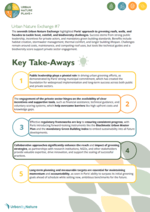
Key Take-Aways UNE #7
Learn more about the key take-aways from our online Urban Nature Exchange #7 about greening the built infrastructure by engaging the private sector.
Read more

The latest session of the Urban Nature Exchanges (UNEs) focused on the greening of urban infrastructure, with Paris as a key example. Paris has successfully integrated green roofs, walls and facades into its urban planning strategy to combat climate-related challenges such as heat waves and heavy rainfall.
In response to increasing climate-related challenges, including heatwaves and intense rainfall, Paris has embraced the greening of buildings as a key strategy for urban resilience. By installing vegetation on rooftops, walls and facades, Paris is addressing multiple urban challenges, from improving biodiversity to improving the quality of life for its residents.
Paris' approach to greening its built infrastructure:
Paris has exceeded its initial target of greening 150 hectares of buildings, achieving 151 hectares ahead of schedule. The city aims to achieve a further 40 hectares by 2030 as part of its biodiversity plan, demonstrating a clear commitment to integrating green infrastructure into its long-term urban planning.
Three main drivers have shaped Paris' strategy for greening its built infrastructure:
Key benefits of greening urban infrastructure
Greening the built environment in Paris has several benefits. Green roofs and walls support biodiversity by creating habitats for wildlife, while improving the quality of life for residents through improved landscapes and thermal comfort. On a citywide scale, greening helps manage stormwater and reduces the urban heat island effect. In addition, green roofs protect buildings by extending the life of waterproofing systems, providing long-term cost savings.
Challenges in engaging the private sector
Engaging the private sector in greening is challenging due to high upfront costs and competition for roof space from other uses such as urban agriculture and solar panels. Long-term maintenance of green roofs also requires resources and expertise that may be lacking in private buildings. To support these efforts, Paris is providing financial incentives and tools such as technical guides and the Biodiversity Score to encourage private investment in green infrastructure.
Key learnings
Moving forward
Paris demonstrates that large-scale change is possible through a combination of strong leadership, private sector collaboration and regulatory frameworks. The city's efforts show that greening the built environment is not just an environmental initiative, but a strategy for building resilience and sustainability. Other cities can draw key lessons from Paris to accelerate their own greening initiatives.
Publishing date: